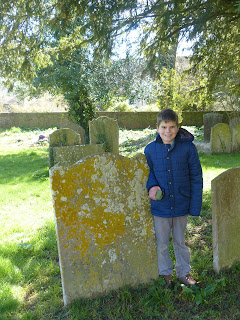On Saturday we drove to Dover. It was a long car trip and as we drove I spotted two muntjac deer, two rabbits, a pheasant, a goshawk, lots of rooks and various farm animals.
Our first stop was Canterbury. We went there to visit its famous Cathedral. However, when we got there we discovered the main parts were closed!
 |
| The front gates of the Cathedral |
 |
| Looking in to the Cathedral |
So after a picture at the front gates, we left Canterbury and headed to Chilham, a small village close to Canterbury. The latest BBC production of Emma by Jane Austen had scenes filmed there in the village square. Also, it is thought that Thomas Beckett might have been buried there.
The main reason we were there was for family tree research as our ancestors, the Pullens, are buried there. We knew they were buried at St Mary's Church there, so when we got to the church (very easy in a small village), dad, Elsie and Lydia searched for records inside, while mum, Rebecca and I looked for the actual grave. Soon dad found where it was from the records and we went to it and took some photos.
 |
| St Mary's church |
 | |
| Next to the grave of my great, great, great, great, great, great grandfather William Pullen |
Huge and powerful, Dover Castle towered over the beach, watching for enemies that might cross the channel to fight the English. Once we were inside its outer walls we visited the Roman lighthouse and Anglo Saxon church. As it was St George's day, flocks of English people had come for the festival. Still, the actual Castle was quite empty and the banners and medieval tents were a great backdrop for the French invasion game that Becca, Elsie and I were playing.
Inside Dover Castle was fantastic. We went inside the mighty stone keep, looked over the battlements, saw the kitchen, guest room, dining room and armoury.
Next we saw the WWII tunnels with corrugated iron walls and dull electric lights. It used to be a hospital for people injured in the war. We took a tour through there.
 |
| Roman lighthouse |
 | ||||||
| White cliffs |
 |
| On the way home we saw this house, where some of our ancestors lived and started a church back in the 1600s! |






















































